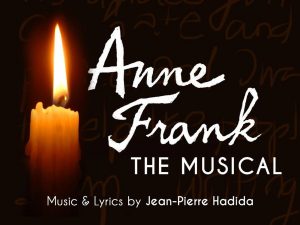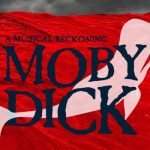In the past few decades the musical as a form of theatre has begun to explore the boundaries of its form by going out of the predefined frame of ‘entertaining play with songs,’ we’ve seen tragic epics in the ‘80’s, politically conscious musicals in the ‘90’s and personal, intimate musicals in the first two decades of the 21st century. And in 2008, somewhere in France, Jean-Piere Hadida must have thought: well why not? Why not make a musical about the diary of Anne Frank?
The musical adapts Anne’s life from the day she got her diary until her death in 1945. After a short opening by a narrator in ‘Het Achterhuis,’ the Annex, have a short scene explaining the origin of the fateful diary and then move onto the day they move into the Secret Annex. The show then chronicles the life of Anne inside the Secret Annex and tries mostly to get the feeling across of how it must have been to live inside of the Annex. It ends, as it did in real life, rather abruptly by Nazis who raid the house and deport the inhabitants.

To adapt Anne’s Diary is to perform an impossible task, the diary is a point-of-view from one person in the Annex. Jean-Piere Hadida therefore tries to interpret Anne’s text to create some scenes that don’t involve her, but unfortunately Jean does not have Anne’s writing prowess. As the diary was an account of the daily life in the Annex, it isn’t dramatically structured the way a play or a movie is. There’s nothing that really drives the story other than the fact that we as an audience are basically waiting for the inevitable, the Nazis. Other theatrical adaptations of ‘Anne Frank’ have therefore tried to find ways to create a dramatic structure. The play ‘Anne,’ for example, that was performed in Amsterdam for a few years following a 2014 premiere added a fictional adult variation of Anne looking back at her diary. They cut back and forth between her and the story creating a dialogue and dramatic tension between her past and future. By introducing a narrator who is visiting the Annex Jean-Piere could have also added some dramatic tension but he never uses the narrator again except for the end. He also doesn’t use the historic mysteries that surround the betrayal of the Franks. He could have added or expanded a role of one of the outside helpers of the Franks to include this as a dramatic plotline. Throughout the play it becomes clear though, that it was never Jean-Piere Hadida’s intention to create an engaging musical about Anne’s life, but to create a musical that brings across the feelings of the trapped Jews during their period in the Annex.
With only weak dialogue and no dramatic set-up the songs follow each other rather quickly and some seem rather unnecessary.
The songs are written well enough, the melodies work especially well as they perform the haunting memories that Anne wrote down in her diary. the melodies remind of old songs on an old-timey radio. But with only weak dialogue and no dramatic set-up the songs follow each other rather quickly and some seem rather unnecessary. There is however one song and one scene that does work exceptionally well in comparison. After a short build-up of Anne and Peter’s relationship, Anne reminisces about the bells of Amsterdam and is later joined by Peter in a beautiful reprise. It is this tenderness and intimateness that I expected to see when I walked into the auditorium.

The set design of the play was very minimal but I think this is a matter of circumstance as well as budget since the show was being performed in the auditorium of the Center for Jewish History. They used a background projection and some props like a few chairs and small standards, but since the actual Annex wasn’t very spacious not much is necessary to suggest the small space. The actors are all well-suited for their roles but since the script doesn’t ask too much of them they all fade away into the background. All of them are vocally very strong as most of them have a form of opera in their background. Krystin Vario makes her professional debut as Anne and she does a good job of portraying the innocence of the character. David Serero, who also directs and produces, portrays Otto, but the combination of his accent with his operatic vocals makes him very hard to understand. He also creates a contrast between him and the others by making grand operatic gestures in his acting while the other actors retain a very understated form of acting. Other stand-outs are Wendel Hester as Peter van Pels, he portrays the boy trapped with girls perfectly but retains a child-like innocence just like Krystin as Anne.
If you’re keen to know how it must have felt in the Annex, or if you want to see a part of history performed the show could be for you.
In the end I’m glad to say that this show works as a perfectly fine musical adaptation of Anne’s work. If you’re looking for a dramatic musical interpretation you shouldn’t see this show but if you’re keen to know how it must have felt in the Annex, or if you want to see a part of history performed the show could be for you. I’m personally glad they named the show ‘Anne Frank, a musical,’ so there’s still the opportunity for ‘the musical’ to come along.
Seen at: the Center for Jewish History, NY, Seen on: 9/17/2019


